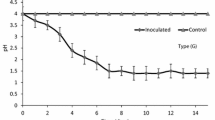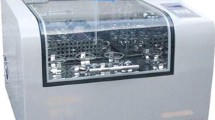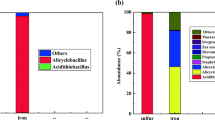Abstract
Bioleaching has been demonstrated to be a feasible technology for removing heavy metals from sewage sludge, but the leaching medium needs to be pre-acidified to less than 4. The objective of the research presented in this paper was to investigate the pH requirement for isolated indigenous Thiobacillus ferrooxidans for bioleaching heavy metals from wastewater sludge in Hong Kong. Isolated sludge-indigenous iron-oxidizing bacteria were used for the bioleaching experiments to investigate the dissolution behaviour of heavy metals (Zn, Cu, Ni and Cr) from sludge set at an initial pH ranging from 3–7 with the purpose to reduce the acid consumption. The results showed that the inoculation of 15% of isolated indigenous iron-oxidizing bacteria and addition of 4.0 g L-1 Fe2+ (in the form of FeSO4⋅7H2O) resulted in a sharp decrease in sludge pH from an initial pH 3–7 to 2.1–2.4 and an increase in ORP (oxidation-reduction potential) from –200–38 mV to > 500 mV within the first 6 days. After 16 days of bioleaching, 50.2–78.4% of Cr, 63.7–74.1% of Cu, 74.9–88.2% of Zn and 15.5–38.6% of Ni can be leached out from the sludge at an initial pH range of 3–7. In contrast, only 1.5% of Cr, 1.7% of Cu, 15.3% of Zn and 15.5% of Ni was solubilized in the control run at pH 7.0. At the end of bioleaching, the dissolution of nutrients N and P from the organic matrix at pH 6 was significantly less than that at pH 3–5. Hence, the bioleaching efficiency could still be maintained at an initial pH of > 4 using the isolated indigenous T. ferrooxidans which would reduce the cost of operation.
Similar content being viewed by others
References
Barrett, J., Hughes, M. N., Karavaiko, G. I. and Spencer, P. A.: 1993, Metal Extraction by Bacterial Oxidation of Mineralits, Eillis Horwood, Chichester.
Blais, J. F., Tyagi, R. D. and Auclair, J. C.: 1992a, 'Bioleaching of metals from sewage sludge by sulfur-oxidizing bacteria', Journal of Environmental Engineering 118, 690–707.
Blais, J. F., Tyagi, R. D. and Auclair, J. C.: 1992b, 'Cooperation between two Thiobacillus strains for trace metals removal from municipal sludge', Canadian Journal of Microbiology 38(3), 181–187.
Blais, J. F., Tyagi, R. D. and Auclair, J. C.: 1993, 'Metals removal from sewage sludge by indigenous iron-oxidizing bacteria', Journal of Environmental Science A28(2), 443–467.
Brierley, C. L.: 1978, 'Bacterial leaching', CRC Critical Reviews in Microbiology 6, 207–262.
Chartier, M. and Couillard, D.: 1997, 'Biological processes: The effect of initial pH, percentage inoculum and nutrient enrichment on the solubilization of sediment bound metals', Water, Air, and Soil Pollut. 96, 249–267.
Couillard, D. and Mercier, G.: 1990, 'Bacterial leaching of heavy metals from sewage sludge-bioreactors comparison', Environmental Pollution 66, 237–253.
Couillard, D. and Mercier, G.: 1991. 'Optimum residence time (in CSTR and airlift reactor) for bacterial leaching of metals from anaerobic sewage sludge', Water Research 25, 211–218.
Couillard, D. and Mercier, G.: 1993, 'Removal of metals and fate of N and P in the bacterial leaching of aerobically digested sewage sludge', Water Research 27, 1227–1235.
Couillard, D., Chartier, M. and Mercier, G.: 1992, 'Optimisation de la solubilization biologique des metaux lourds dans les boues aerobies en mode cuvee', Rapport Scientifique No. 348, INRS-Eau, Université du Quebec, pp. 212.
Dugan, P. R. and Apel, W. A.: 1978, 'Microbiological Desulfurization of Coal', in L. F. Murr, A. E. Torma and J. A. Brierley (eds), Metallurgical Application of Bacterial Leaching and Related Microbiology Phenomena, Academic Press, New York, pp. 232–250.
Janzen, H. H. and Bettany, J. R.: 1987, 'Oxidization of elemental sulphur under field condition in central Saskatchewan', Canadian Journal of Soil Science 67(3), 609–618.
Kelly, D. P. and Harrison, A. P.: 1988, 'Genus thiobacillus. Bergey's Manual of Determinative Bacteriology', in J. G. Holt, J. T. Staley, M. P. Bryant and N. Pfennig (eds), Williams & Wilkins Co., Baltimore, Md. 3, pp. 1842–1858.
Norris, P. R.: 1990, 'Acidophilic Bacteria and Their Activity in Mineral Sulphide Oxidation', in H. L. Ehrlich and C. L. Brierley, (eds), Microbial Mineral Recovery, McGraw-Hill, New York, pp. 3–28.
Page, A. L., Gleason, T. L. and Smith, J. E.: 1983, 'Utilization of Municipal Wastewater and Sludge on Land', in I. K. Isandar, and L. E. Sommers (eds), Proc. Workshop USEPA, U.S. Army Corps of Engineers, USDA-CSRS, NSF, and Univ. of California-Kearney Foundation of Soil Science, Denver Co. 23-25 February, University of Califormia, Riverside, CA.
Pogliani, C. and Donati, E.: 1999, 'The role of exopolymers in the bioleaching if a non-ferrous metal sulphide', Industrial Microbiology and Biotechnology 22, 88–92.
Ralph, M.: 1974, Introduction to Environmental Microbiology, Prentice-hall, Inc., Englewood Cliffs, New Jersey. pp. 213–215.
Sand, W. T. G., Hallmann, R. and Schippers, A.: 1995, 'Sulphur chemistry, biofilm, and the (in)direct attack mechanism — A critical evaluation of bacterial leaching' Applied Microbiology and Biotechnology 43, 961–966.
Shanableh, A. and Ginige, P.: 1999, 'Impact of metals bioleaching on the nutrient value of biological nutrient removal biosolids', Water Science and Technology 39(6), 175–181.
Sterrit, R. M. and Lester, J. N.: 1980, 'The value of sewage sludge to agriculture and effects of the agricultural use of sludges contaminated with toxic elements: A review', Science of Total Environment 16, 55–90.
Tyagi, R. D. and Couillard, D.: 1989, 'Bacterial Leaching of Metals from Sludge', in P. E. Cheremisinoff (ed.), Wastewater Treatment Technology, Encyclopedia of Environmental Control Technology, Vol. 3, Gulf Publishing Co., Houston, Tex., pp. 557–591.
Tyagi, R. D. and Couillard, D.: 1987, 'Bacterial leaaching of metal from digested sewage sludge', Process Biochemistry 22, 114–117.
Tyagi, R. D. and Tran, F. T.: 1991, 'Microbial leaching of metals from digested sewage sludge in continuous system', Environmental Technology 12(4), 303–312.
Tyagi, R. D., Couillard, D. and Tran, F. T.: 1988, 'Heavy metals removal from anaerobically digested sludge by chemical and microbiological methods', Environmental Pollution 50, 295–316.
Tyagi, R. D., Couillard, D. and Tran, F. T.: 1990, 'Studies on microbial leaching of heavy metals from municipal sewage sludge', Water Science Technology 22(12), 229–238.
Wong, L. and Henry, J. G.: 1988, 'Bacterial Leaching of Heavy Metals from Anaerobically Digested Sludge', in D. L. Wise (ed.), Biotreatment Systems, Vol. II, CRC Press, Boca Raton, FL, U.S.A., pp. 125–169.
Woziak, D. J. and Huang, J. V. C.: 1982, 'Variables affecting metal removal from sludge', Journal of Water Pollution Federation 54, 1574–1580.
Xiang, L., Ke J. and Qui, R.: 1998, 'Influence of Some Physical Chemistry Factors on the Growth of Thiobacillus ferrooxidans Strain8#', in Yang Xianwan, Chen Qijuan and He Aiping (eds), Proceedings of the Third International Conference on Hydrometallury, Kunming, November 3-5, pp. 227–232.
Xiang, L., Chan, L. C. and Wong, J. W. C.: 2000, 'Removal of heavy metals from anaerobically digested sewage sludge by isolated indigenous iron-oxidizing bacteria', Chemosphere 41, 283-287.
Author information
Authors and Affiliations
Corresponding author
Rights and permissions
About this article
Cite this article
Wong, J.W.C., Xiang, L. & Chan, L.C. pH Requirement for the Bioleaching of Heavy Metals from Anaerobically Digested Wastewater Sludge. Water, Air, & Soil Pollution 138, 25–35 (2002). https://doi.org/10.1023/A:1015503828607
Issue Date:
DOI: https://doi.org/10.1023/A:1015503828607




